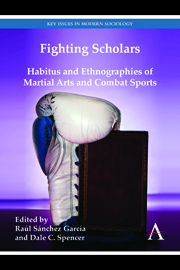Book contents
- Frontmatter
- Dedication
- Epigraph
- Contents
- Contributors
- Glossary
- Chapter 1 Introduction: Carnal Ethnography as Path to Embodied Knowledge
- Chapter 2 Habitus as Topic and Tool: Reflections on Becoming a Prizefighter
- Chapter 3 In Search of a Martial Habitus: Identifying Core Dispositions in Wing Chun and Taijiquan
- Chapter 4 Each More Agile Than the Other: Mental and Physical Enculturation in Capoeira Regional
- Chapter 5 ‘There Is No Try in Tae Kwon Do’: Reflexive Body Techniques in Action
- Chapter 6 ‘It Is About Your Body Recognizing the Move and Automatically Doing It’: Merleau-Ponty, Habit and Brazilian Jiu-Jitsu
- Chapter 7 ‘Do You Hit Girls?’: Some Striking Moments in the Career of a Male Martial Artist
- Chapter 8 The Teacher's Blessing and the Withheld Hand: Two Vignettes of Somatic Learning in South India's Indigenous Martial Art Kalarippayattu
- Chapter 9 White Men Don't Flow: Embodied Aesthetics of the Fifty-Two Hand Blocks
- Chapter 10 Japanese Religions and Kyudo (Japanese Archery): An Anthropological Perspective
- Chapter 11 Taming the Habitus: The Gym and the Dojo as ‘Civilizing Workshops’
- Chapter 12 ‘Authenticity’, Muay Thai and Habitus
- Chapter 13 Conclusion: Present and Future Lines of Research
- Epilogue Homines in Extremis: What Fighting Scholars Teach Us about Habitus
- References
Chapter 10 - Japanese Religions and Kyudo (Japanese Archery): An Anthropological Perspective
Published online by Cambridge University Press: 05 March 2014
- Frontmatter
- Dedication
- Epigraph
- Contents
- Contributors
- Glossary
- Chapter 1 Introduction: Carnal Ethnography as Path to Embodied Knowledge
- Chapter 2 Habitus as Topic and Tool: Reflections on Becoming a Prizefighter
- Chapter 3 In Search of a Martial Habitus: Identifying Core Dispositions in Wing Chun and Taijiquan
- Chapter 4 Each More Agile Than the Other: Mental and Physical Enculturation in Capoeira Regional
- Chapter 5 ‘There Is No Try in Tae Kwon Do’: Reflexive Body Techniques in Action
- Chapter 6 ‘It Is About Your Body Recognizing the Move and Automatically Doing It’: Merleau-Ponty, Habit and Brazilian Jiu-Jitsu
- Chapter 7 ‘Do You Hit Girls?’: Some Striking Moments in the Career of a Male Martial Artist
- Chapter 8 The Teacher's Blessing and the Withheld Hand: Two Vignettes of Somatic Learning in South India's Indigenous Martial Art Kalarippayattu
- Chapter 9 White Men Don't Flow: Embodied Aesthetics of the Fifty-Two Hand Blocks
- Chapter 10 Japanese Religions and Kyudo (Japanese Archery): An Anthropological Perspective
- Chapter 11 Taming the Habitus: The Gym and the Dojo as ‘Civilizing Workshops’
- Chapter 12 ‘Authenticity’, Muay Thai and Habitus
- Chapter 13 Conclusion: Present and Future Lines of Research
- Epilogue Homines in Extremis: What Fighting Scholars Teach Us about Habitus
- References
Summary
Introduction
Yawatashi is performed by the highest-ranking teachers at the opening of each public kyudo (Japanese archery) event such as grade (dan) tests, tournaments and seminars. This highly prestigious ceremony is intended to ensure the well-being of the participants and the auspicious progress of the events. Yawatashi sets into motion a complex cosmos in which the archers will act in the course of the ensuing event. In two separate interviews I conducted in Tokyo, I asked two senior teachers, Sakamoto-sense and Ishigawa-sense, about the meaning of yawatashi. Sakamoto, a senior teacher in the Honda school of kyudo, gave me a detailed and informed answer, explaining how the ceremony calls on the Shinto kami to give the arrows over for the event and thereby ensure its safe unfolding. The other interview was with Ishigawa-sense, a central figure in the ‘All Nippon Kyudo Federation’, senior teacher at the Shiseikan — the main kyudojo in Tokyo situated at the Meiji Jingu Shinto shrine complex — who is also head of the Tachikawa school and served as leader of the Japanese delegation to the European kyudo federation's summer seminars in 2009. I have watched him perform yawatashi to perfection several times, at the most important kyudo events in Tokyo; he registered slight surprise at my question about the meaning of the ceremony, replying only, ‘That's how we always do it!’
- Type
- Chapter
- Information
- Fighting ScholarsHabitus and Ethnographies of Martial Arts and Combat Sports, pp. 141 - 154Publisher: Anthem PressPrint publication year: 2013



